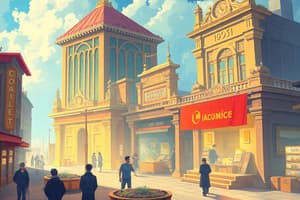Podcast
Questions and Answers
What condition does the monopolist seek to achieve when maximizing profit?
What condition does the monopolist seek to achieve when maximizing profit?
- Produce the quantity output at which MR=MC (correct)
- Produce the quantity output at which P=MC
- Produce the quantity output at which ATC=MC
- Produce the quantity output at which P=MR
In perfect competition, what curve is the same as the firm's MR curve?
In perfect competition, what curve is the same as the firm's MR curve?
- Marginal cost curve
- Average variable cost curve
- Demand curve (correct)
- Average total cost curve
Why does the MR curve lie below the demand curve in monopoly?
Why does the MR curve lie below the demand curve in monopoly?
- MR>MC
- Demand is perfectly elastic
- P=MR
- P>MR (correct)
At the profit-maximizing quantity Q1, what is the relationship between price and marginal cost in monopoly?
At the profit-maximizing quantity Q1, what is the relationship between price and marginal cost in monopoly?
Why is a monopolist considered not resource allocative efficient at Q1?
Why is a monopolist considered not resource allocative efficient at Q1?
What factor determines whether profits are earned in monopoly at Q1?
What factor determines whether profits are earned in monopoly at Q1?
What does the monopolist charge at Q1 in terms of profit maximization?
What does the monopolist charge at Q1 in terms of profit maximization?
Which price does the monopolist charge at Q1 if P1 is less than ATC?
Which price does the monopolist charge at Q1 if P1 is less than ATC?
What relation must hold for a monopolist to maximize profit?
What relation must hold for a monopolist to maximize profit?
How does the demand curve differ between monopoly and perfect competition?
How does the demand curve differ between monopoly and perfect competition?
Flashcards are hidden until you start studying




